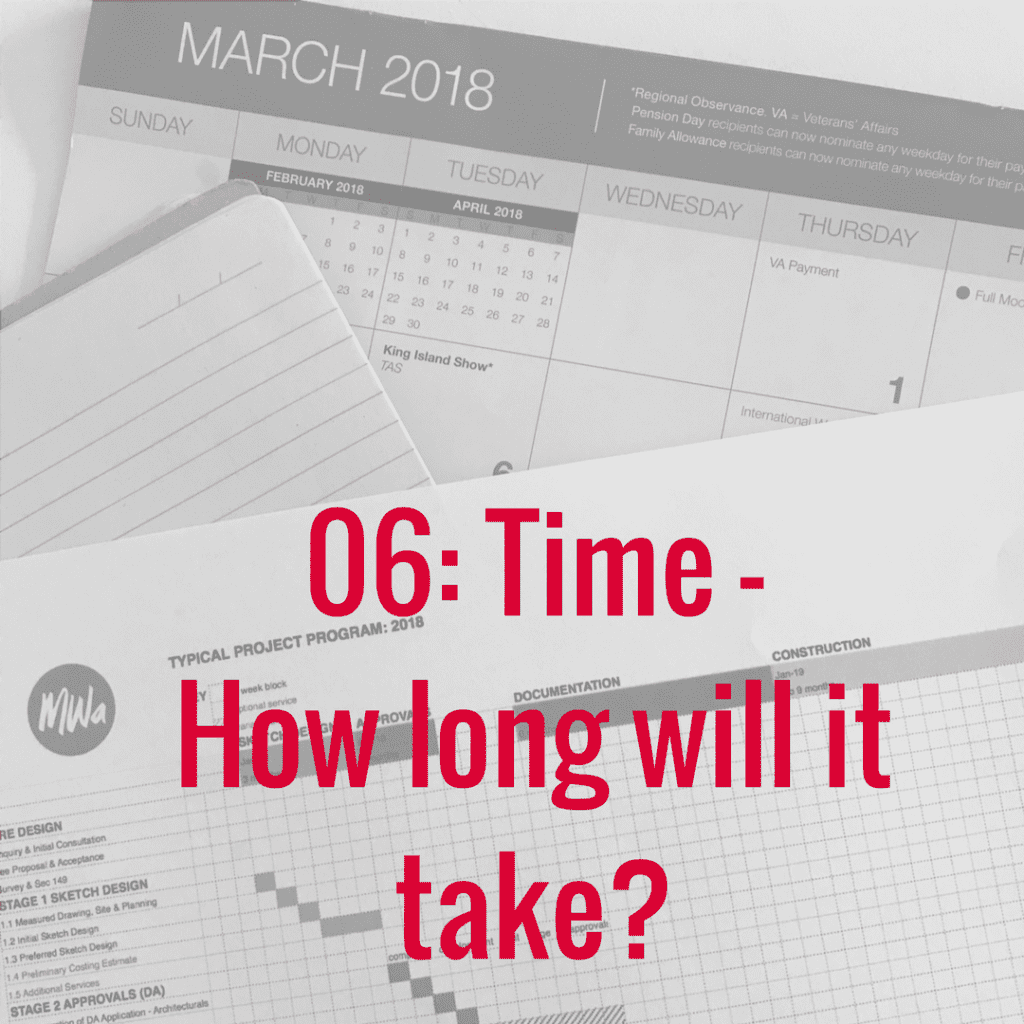6 RESIDENTIAL RENOVATION TIME – How long will it take? And how to cut six months off a renovation.

6 Residential Renovation Time – How long will it take? And how to cut six months off a renovation.
Most prospective clients are interested in how long will their residential renovation will take. (residential renovation time how long will it take?)
In Sydney, with our current planning framework, and for a reasonable size renovation which requires DA approval with Council, the short answer is about two years from start to finish, from an initial consultation with an architect to completion on-site and move in.
This is not what most prospective clients want to hear.
What takes so long?
Regardless of client pressure and expectations on time frame, most projects have to step through the process of feasibility and initial design, approvals, documentation, tendering, appointing a builder, construction approvals and then the construction on-site.
It’s complex and requires a team of people working together in sequence, each contributing what’s necessary at the right time, to keep the project on track.
Generally, preparing to get onto the building site will take longer than the construction on-site.
The cliche “Rome wasn’t built in a day” still rings true.
However, there are 5 factors which can significantly impact a project timeline.
If TIME is important to you, knowing the following can save you at least 6 months of time, depending on your circumstances:
1 Get your finances in order, and match your spend with your project budget.
Regardless of following any of the other factors included in this article, the single reason why project timelines extend on residential projects is the client decision making process around money. This takes up the most amount of time throughout the entire process. Projects which run smoothly and swiftly have decisive clients, where finances are aligned with the project scope.
2 Follow MWa’s advice and and prepare well.
Know your brief, engage the right architect, step through the sketch design process to set the strategy and vision. This is common sense. Starting your project off on the right track will save you time with a more efficient process. Successful projects move along consistently at each step of the process. There are no delays and hand-wringing over decisions. Your decisions are easy when your vision is clear.
3 Avoid a DA approval completely.
If your site is eligible, consider tailoring your project to suit an approval via the NSW General Housing Code for Exempt and Complying Development. In most cases, this will save at least six months off your renovation time frame, if not more. It will save time in preparing documents for the DA submission (which are not needed for a CDC application), and then the time Council takes to consider the DA (often between three and six months). A CDC application may also save you money, with less fees and less time. See more on this in 8. Manage Costs, Save Money.
4 If you have to do a DA, then there are a couple suggestions to reduce the DA time:
Progress the DA process smoothly and efficiently with a well run application lead by a good architect. Factors such as submitting a robust design and a thorough DA submission (maybe even a Pre DA session with Council), as well as maintaining good neighbourly relations, can also save time through the DA process.
Don’t wait for your DA to be approved to commence detailed documentation for tender and construction. Liaise with your architect to assess the risk of moving on to the next stage of work, before the DA approval is final. Commence documentation for tender/construction/construction certificate as soon as the indicators are positive that the DA submitted design is to be approved. Some councils take weeks to process the final DA release.
5 Don’t do a competitive tender.
Select your preferred builder early on, for example Sketch Design stage, and enjoy the benefits that come with working with a trusted builder involved in the process.
No matter what the anticipated time program, or the benefits of a competitive tender are, it takes TIME.
In 2018, with a busy residential sector, the tender process is taking longer than anticipated. Lining up three to four builder to tender, briefing them, providing them the usual 3 weeks time to tender, which in some cases invariable extends to 4 to 6 weeks – adds time. Assessing tenders, meeting with a preferred tender, negotiating the details, identifying cost savings (note factor #1 above about aligning your brief and budget), documenting changes and agreements for contract signing – can take 3 months all up.
And then the builder needs to have finished their last project and be ready to start on yours.
Selecting your preferred and trusted builder early speeds up this process, as the issues can be resolved earlier in the process.
There are benefits to doing a competitive tender. It’s human nature to want choice and to know what’s a fair and reasonable price for your renovation – the going market rate. Often clients go with the tendering builder they already know or has the most established relationships anyway. It’s never best to select a builder on price alone.
You can save TIME by selecting a builder earlier in the process, based on criteria other than COST.
Conclusion
At MWa, our shortest time frame in recent years has been 7 months from initial consultation to starting on site. That’s our office record, going down the CDC route and building selected by the client early on, with no competitive tender.
A more usual time frame is 12 months, for a project including a smooth DA approval and where the client’s brief and budget are aligned so their decision making is fast.
Read on…click below on MWa’s client advice articles:
1 Architects – Do you need one? Is your project suitable?
3 Your Architect – A Good Match: How to find the right architect.
4 Process: Strategy, Vision, Compliance, Detail & Delivery: How it all works
6 Time – How long will it take?: How to cut six months off a renovation time frame.
8 Manage Costs, Save Money: 10 Ways to Manage Costs, 10 Ways to Save Money
